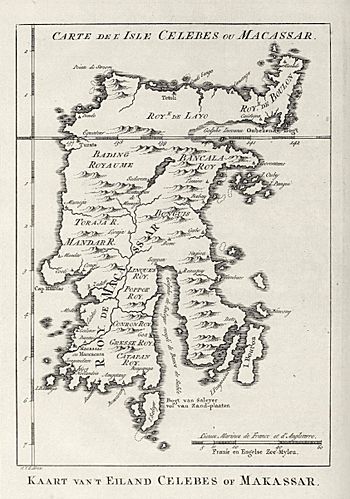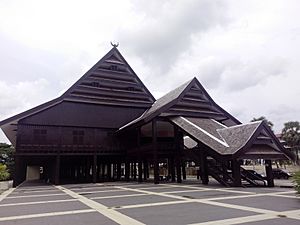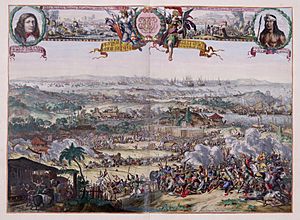Sultanate of Gowa facts for kids
The Sultanate of Gowa was a powerful kingdom in Indonesia, especially successful in the South Sulawesi region. The people of this kingdom were from the Makassar tribe, living on the southern and western coasts of Sulawesi. It's important not to confuse it with Goa in India!
Quick facts for kids
Sultanate of Gowa
ᨔᨚᨅᨐ ᨑᨗ ᨁᨚᨓ
Sombaya ri Gowa (Makasar) |
|||||||||||
|---|---|---|---|---|---|---|---|---|---|---|---|
| 14th century–1945 | |||||||||||
|
Flag
|
|||||||||||
 |
|||||||||||
| Status | Part of Indonesia | ||||||||||
| Capital | Tamalate (1320–1548) Somba Opu (1548–1670) Jongaya (1895–1906) Sungguminasa (1936–present) |
||||||||||
| Common languages | Makassarese | ||||||||||
| Religion | Sunni Islam | ||||||||||
| Government | Monarchy | ||||||||||
| Sultan | |||||||||||
|
• 1300
|
Tumanurung | ||||||||||
|
• 1653-1669
|
Sultan Hasanuddin Tuminanga ri Balla'pangkana | ||||||||||
|
• 1946-1978
|
Sultan Muhammad Abdul Kadir Aiduddin | ||||||||||
| History | |||||||||||
|
• Established
|
14th century | ||||||||||
|
• Dissolution of Sultanate
|
1945 | ||||||||||
| Currency | No official currency, the Barter system was used | ||||||||||
|
|||||||||||
| Today part of | Indonesia (as Gowa Regency) |
||||||||||
Contents
History of the Gowa Kingdom
The Gowa region was known as Makassar before the kingdom was formed. Its people were called Suku Makassar (the Makassar tribe). The kingdom's history is split into two main periods: before Islam and after Islam.
Early Gowa: Before Islam
The first queen of Gowa was Tomanurung Baine. We don't know much about when the kingdom started or about this first queen.
Later, around the time of the 6th king, Tonatangka Kopi, the kingdom split into two. His two sons led these new kingdoms:
- The Kingdom of Gowa was led by Batara Gowa.
- The Kingdom of Tallo was led by Karaeng Loe ri Sero.
These two kingdoms often fought. Eventually, Tallo was defeated by Gowa. During the rule of the 10th King of Gowa, I Manriwagau Daeng Bonto Karaeng Lakiung Tunipalangga Ulaweng (1512-1546), the two kingdoms joined together again. They made a special agreement called Rua Kareng se're ata, which means "dual kings, single people" in the Makassarese language. After this, if someone became king of Tallo, they also became king of Gowa. Many historians simply called these "twin kingdoms" either "Makassar" or "Gowa."
Gowa Becomes an Islamic Sultanate
Islam arrived in South Sulawesi as early as the 1320s. The Gowa kingdom officially became Islamic on September 22, 1605. The 14th king, Karaeng Matowaya Tumamenaga Ri Agamanna, converted to Islam and changed his name to Sultan Alauddin. He ruled from 1591 to 1629. Three important religious scholars, called ulama, from Minangkabau helped with this conversion. Their names were Datuk Ri Bandang, Datuk Ri Tiro, and Datuk Ri Pattimang.
From 1630 onwards, the leaders of Gowa and its religious officials were usually from noble families. In 1607, the sultans of Makassar decided to welcome all foreign traders. This led to an English trading post being built in Makassar in 1613. This also started some conflicts between the English, the Dutch, and Makassar.
The most famous Sultan of Gowa was Sultan Hasanuddin. From 1666 to 1669, he fought a big war against the Dutch East India Company (VOC). The Dutch were helped by Arung Palakka, a prince from the Bone kingdom.
The Makassar War (1666-1669)
In 1666, the Dutch East India Company (VOC) wanted to control the smaller kingdoms in the North. However, they couldn't easily defeat the Sultanate of Gowa. Sultan Hasanuddin, who became the 16th sultan of Gowa, tried to unite the smaller kingdoms in eastern Indonesia to fight the VOC.
The war began in 1666. The VOC, led by Admiral Cornelis Speelman, had many ships and soldiers, including troops from Ambon and Bugis fighters led by Arung Palakka. The war lasted until 1669. On November 18, 1667, a peace agreement called the Treaty of Bungaya was signed.
However, Sultan Hasanuddin felt unfairly treated and started fighting again. The VOC brought in more soldiers from Batavia (now Jakarta). Fierce battles took place. The Dutch forces became stronger and finally broke through Gowa's strongest fort, Somba Opu, on June 12, 1669. This marked the end of the war. Sultan Hasanuddin stepped down from his throne and passed away on June 12, 1670.
After the war, Admiral Cornelis Speelman destroyed the large Somba Opu fortress. He then built Fort Rotterdam in its place, naming it after his hometown in the Netherlands. This fort became the main base for VOC activities in Sulawesi. In 1672, Arung Palakka became the sultan of Bone. The Makassar War is considered one of the biggest wars the VOC ever fought.
End of the Sultanate
After 1673, the area around Fort Rotterdam grew into the city we now know as Makassar. In 1904, the Dutch colonial government started a war against the small kingdoms in South Sulawesi, including Gowa. In 1911, the Sultanate of Gowa lost its independence after losing this war. It became a region under Dutch control.
When Indonesia gained independence from the Netherlands in 1945, the Sultanate of Gowa officially ended. Its former territory became part of the Republic of Indonesia and is now known as Gowa Regency.
How Gowa Was Governed
The Sultanate of Gowa had a clear way of governing its lands. The main leader was the Sultan. He was helped by important advisors and ministers.
One very important role was the Tumabicarabutta. This person acted as the Sultan's chief advisor and could even be a regent (someone who rules when the king is too young or unable to). Often, the ruler of Tallo would serve as the Tumabicarabutta for the ruler of Gowa.
Another key group was the Tumailalang, which means "the person on the inside." These were a group of ministers who managed the daily affairs of Gowa. At first, there was one main Tumailalang, but later there were two: an elder one (tumailalang toa) and a younger one (tumailalang lolo). All these important government positions were held by high-ranking nobles.
List of Gowa Rulers (Simplified)
The Islamic period of Gowa began in 1605 with Sultan Alau'ddin. Here are some of the notable rulers:
| No | Monarch | Reign |
|---|---|---|
| 1 | Tumanurung Baine | Mid-14th century |
| 9 | Daeng Matanre Karaeng Tumapa'risi' Kallonna | Late 1510/early 1511 - late 1546 |
| 10 | I Manriwagau Daeng Bonto Karaeng Lakiung Tunipalangga Ulaweng | 1546 - 1565 |
| 14 | I Mangari Daeng Manrabbia Sultan Alau'ddin | 1593 - 15 June 1639 |
| 16 | I Mallombassi Daeng Mattawang Karaeng Lakiyung Bonto Mangape Sultan Hasanuddin | 1653 - 17 June 1669 |
| 34 | I Makkulau Daeng Serang Karaeng Lembangparang Sultan Husain | 18 May 1895 - 13 April 1906 |
| 35 | I Mangimangi Daeng Matutu Karaeng Bonto Nompo Sultan Muhammad Tahur Muhibuddin | 1936 - 1946 |
| 36 | Andi Ijo Daeng Mattawang Karaeng Lalolang Sultan Muhammad Abdul Kadir Aiduddin | 1956 - 1960 |
Images for kids












